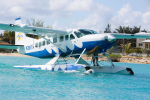farmrjohn
Pre-takeoff checklist
- Joined
- Mar 26, 2018
- Messages
- 453
- Display Name
Display name:
farmrjohn
The video was just posted today, don't know if the incident was today or earlier. Miami Water Landing
You snag the front of it, and peel it off.Took me a few seconds to realize the footage was sped-up and the prop was not turning as fast as depicted.
I thought floats were designed with multiple watertight compartments so you could't flood the whole thing. Even with a hard water landing, how do you breach the entire float?
Don't have to rupture the whole float. Just bust it open enough so that a couple of the compartments fill. The remainder aren't enough to keep the float on the surface. You will note that there had to be some buoyancy remaining, otherwise the airplane would have turned over.Took me a few seconds to realize the footage was sped-up and the prop was not turning as fast as depicted.
I thought floats were designed with multiple watertight compartments so you could't flood the whole thing. Even with a hard water landing, how do you breach the entire float?


Holy smokes - they sure got rescued quickly. And as soon as they got it towed in, there was crane there. I know it was speeded up video but it was amazingly fast recovery.
I made almost that same landing this morning in a nice cross wind except I was on a runway so all I did was bounce high enough to get another lap around the pattern!!
Since it didn't spend too much time in the water, and most likely it has sort of corrosion protection treatment, I would think a thorough rinse and inspection might save it?
I don't know about turbines, but I don't know of a single slow speed sinking that has ever totalled a plane. They're usually flying again within about 2-4 months of getting dunked.Nope, I'm afraid it's done. A fresh water dunking can usually be fixed with enough $$$$; however salt water is a pretty good conductor which destroys anything of an electronic nature and initiates corrosion of disimmilar metals. A further problem is the prop strike of a turbine engine and immersion of engine hot sections.
The video shows the Caravan in the water for almost 13 minutes; however, the video was "fast forwarded" for a time and edited. Does anyone on this forum know how long it was actually in the water? I don't know how much corrosion prevention is done at the Cessna factory, but maybe if they knew a particular airplane was slated for float plane service they might provide added protection ... ? By the way, unless that recovery barge and crane were quite close by, just getting it to the accident site could take several hours.
legally, a single float is required to have at least 80% of the buoyancy of the aircraft at Max gross. It also is required to be operable (not flyable) with 2 compartment flooded.Don't have to rupture the whole float. Just bust it open enough so that a couple of the compartments fill. The remainder aren't enough to keep the float on the surface.
Not much reserve buoyancy there.
It might fly again, but I'd guess its going to develop corrosion in some areas. I'm not sure you can ever get all the salt out of it. But, by the time you put in a new engine, new prop, and replace all the electrical that got wet, it could very well be totaled.Since it didn't spend too much time in the water, and most likely it has sort of corrosion protection treatment, I would think a thorough rinse and inspection might save it?
there is construction going for a new terminal just east of the RC FREEDOM (the farthest boat in the frame) so there are a bunch of barges and floating cranes working in that area. might have been one of them. i was on that boat the friday before. the response time for the rescue boats was short because any time there is are cruse ships on the dock law enforcement boats are all over the channel constantly. miami dade, Florida FWL, USCG all patrol that channel constantly.Nope, I'm afraid it's done. A fresh water dunking can usually be fixed with enough $$$$; however salt water is a pretty good conductor which destroys anything of an electronic nature and initiates corrosion of disimmilar metals. A further problem is the prop strike of a turbine engine and immersion of engine hot sections.
The video shows the Caravan in the water for almost 13 minutes; however, the video was "fast forwarded" for a time and edited. Does anyone on this forum know how long it was actually in the water? I don't know how much corrosion prevention is done at the Cessna factory, but maybe if they knew a particular airplane was slated for float plane service they might provide added protection ... ? By the way, unless that recovery barge and crane were quite close by, just getting it to the accident site could take several hours.
